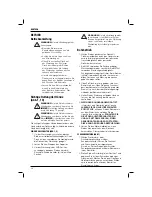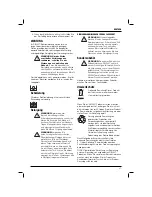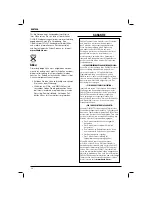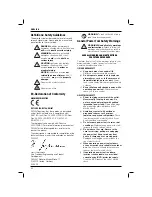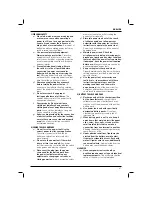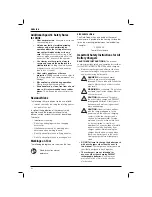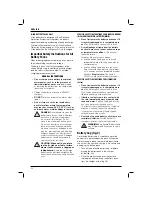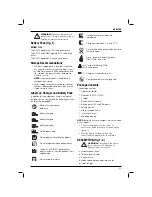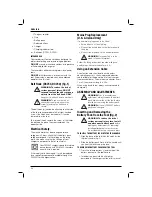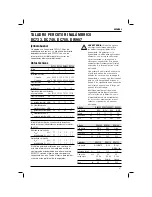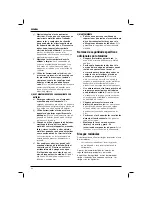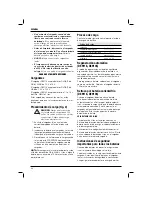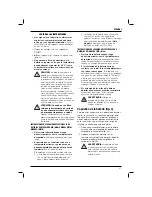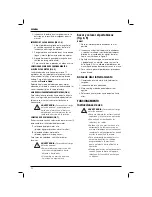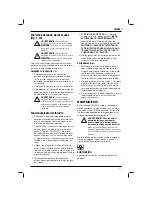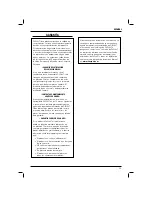
ENGLISH
38
3. To lock the tool in the off position, move the
forward/reverse slider (b) to the central position.
WARNING:
To reduce the risk of
personal injury the drill is equipped with
a brake to stop the tool as soon as the
variable speed switch is fully released.
Drill Operation
1. Select the desired speed/torque range using the
gear shifter to match the speed and torque to
the planned operation.
2. For WOOD, use twist bits, spade bits, power
auger bits or hole saws. For METAL, use high-
speed steel twist drill bits or hole saws. Use
a cutting lubricant when drilling metals. The
exceptions are cast iron and brass which should
be drilled dry.
3. Always apply pressure in a straight line with the
bit. Use enough pressure to keep the drill bit
biting, but do not push hard enough to stall the
motor or deflect the bit.
4. Hold tool firmly with both hands to control the
twisting action of the drill.
5.
IF DRILL STALLS,
it is usually because it
is being overloaded.
RELEASE TRIGGER
IMMEDIATELY,
remove drill bit from work, and
determine cause of stalling.
DO NOT CLICK
TRIGGER OFF AND ON IN AN ATTEMPT
TO START A STALLED DRILL – THIS CAN
DAMAGE THE DRILL.
6. Keep the motor running when pulling the bit
back out of a drilled hole. This will help prevent
jamming.
SCREWDRIVING (FIG. 1)
1. Select forward or reverse rotation using the
slider (b). Match the speed and torque to the
planned operation. Insert the desired fastener
accessory into the chuck as you would any drill
bit.
2. Set the collar (d) to position 1 and begin
screwdriving (low torque). Make a few practice
runs in scrap or unseen areas to determine the
proper position of the clutch collar.
3. If the clutch ratchets too soon, adjust the collar
to increase the torque as required.
MAINTENANCE
Your D
E
WALT power tool has been designed to
operate over a long period of time with a minimum
of maintenance. Continuous satisfactory operation
depends upon proper tool care and regular cleaning.
WARNING: To reduce the risk of
serious personal injury, turn tool off
and disconnect battery pack
before
making any adjustments or removing/
installing attachments or accessories.
An accidental start-up can cause injury.
The charger is not serviceable. There are no
serviceable parts inside the charger.
Lubrication
Your power tool requires no additional lubrication.
Cleaning
WARNING:
Blow dirt and dust out of
the main housing with dry air as often as
dirt is seen collecting in and around the
air vents. Wear approved eye protection
and approved dust mask when
performing this procedure.
WARNING:
Never use solvents or
other harsh chemicals for cleaning the
non-metallic parts of the tool. These
chemicals may weaken the materials
used in these parts. Use a cloth
dampened only with water and mild
soap. Never let any liquid get inside the
tool; never immerse any part of the tool
into a liquid.
CHARGER CLEANING INSTRUCTIONS
WARNING:
Shock hazard. Disconnect
the charger from the AC outlet before
cleaning. Dirt and grease may be
removed from the exterior of the charger
using a cloth or soft non-metallic brush.
Do not use water or any cleaning
solutions.
Summary of Contents for DC733
Page 1: ...DC733 DC740 DC750 DW907 www eu ...
Page 3: ...1 DC733 DC740 m n Figure 1 a b c h d e f DC733 DC740 DC750 j i a b c h d e DW907 j f i ...
Page 4: ...2 Figure 5 Figure 4 p e q j Figure 2 A B Figure 3 k l o o ...
Page 5: ...3 Figure 6 b f Figure 8 Figure 10 Figure 7 Figure 9 ...
Page 171: ...ΕΛΛΗΝΙΚΑ 169 ...



